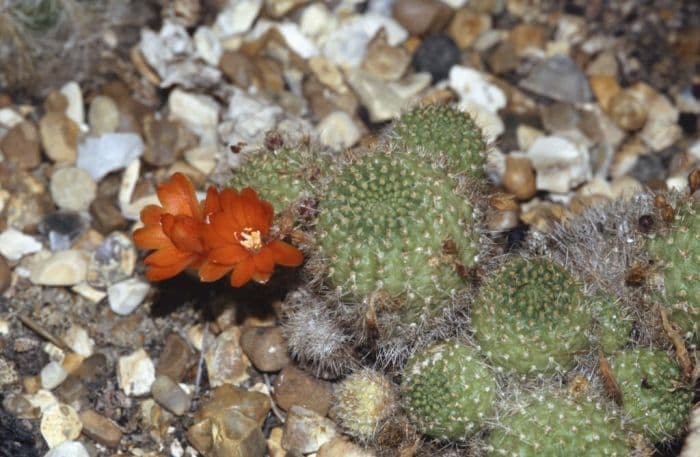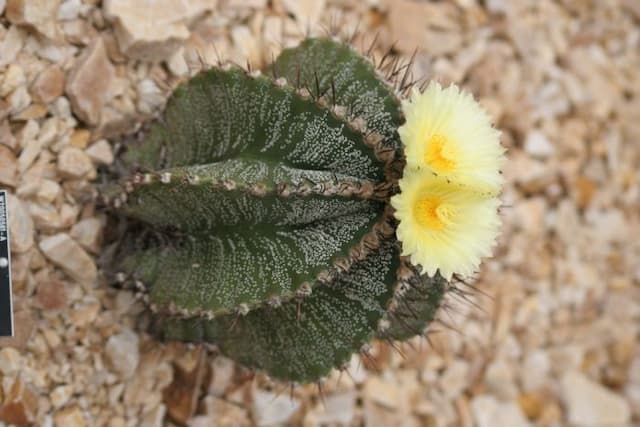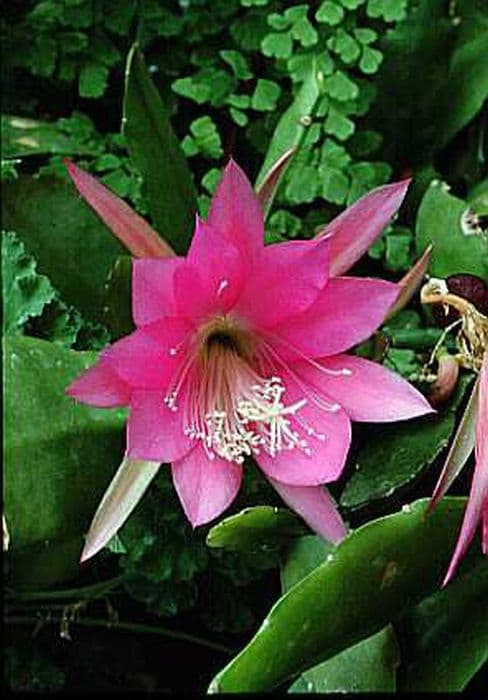Crown Cactus Rebutia fiebrigii 'Donaldiana'

ABOUT
The Rebutia fiebrigii 'Donaldiana', commonly referred to as simply Donald's Crown Cactus, is a small, globular cactus that often grows in clusters. Its rich green body is comprised of many spiraling ribs adorned with areoles from which emerge small, fine spines that can range from white to yellowish in color. The spines are generally short and form a dense, protective layer over the cactus. During the blooming season, Donald's Crown Cactus is known for its vibrant and eye-catching flowers. These flowers are large in relation to the body of the cactus and come in a stunning orange to red color. The petals of these flowers are numerous and form a funnel shape, providing a striking contrast against the green of the cactus body. The plant's surface texture is rough due to the presence of spines and ribbed contours, while the flowers have a softer, delicate texture. The overall appearance of Donald's Crown Cactus with its flowers in bloom is quite exquisite, making this plant a favored choice for cactus enthusiasts and those looking for an ornamental plant with a dramatic flair.
About this plant
 Names
NamesSynonyms
Crown Cactus, Orange Crown Cactus, Orange Snowball, Orange Snowball Cactus, Rebutia 'Donaldiana'.
Common names
Rebutia fiebrigii var. donaldiana, Rebutia donaldiana
 Toxicity
ToxicityTo humans
The Rebutia fiebrigii, commonly referred to as the Crown Cactus, is not known to be toxic to humans. Therefore, ingestion of this plant typically does not result in any symptoms of poisoning. However, as with any non-food plant, ingesting any part of the Crown Cactus could potentially cause mild stomach discomfort due to the plant matter not being intended for consumption.
To pets
The Crown Cactus is not considered toxic to pets. There is no known toxicity reported in animals such as cats and dogs from ingesting parts of this plant. Nevertheless, it is always advisable to discourage pets from chewing on ornamental plants as they may cause mechanical injury or digestive upset due to the plant's texture or non-digestible fibers.
 Characteristics
CharacteristicsLife cycle
Perennials
Foliage type
Evergreen
Color of leaves
Green
Flower color
Varies
Height
0.5 inches (1.27 cm)
Spread
0.5 inches (1.27 cm)
Plant type
Cactus
Hardiness zones
9
Native area
Bolivia
Benefits
 General Benefits
General Benefits- Ornamental appeal: The 'Donaldiana' variety, commonly known as Crown Cactus, has bright, attractive flowers that enhance the aesthetic of gardens and indoor spaces.
- Easy maintenance: Crown Cactus is a low-maintenance plant that requires minimal watering, making it suitable for those with busy lifestyles or for beginner gardeners.
- Compact growth: Its small size makes it ideal for cultivation in containers, on windowsills, or in small spaces.
- Drought tolerance: Adapted to arid environments, the Crown Cactus is highly drought-resistant, requiring infrequent watering and thriving in dry conditions.
- Adaptability: It can be grown in a variety of climates, as long as it is protected from extreme cold and frost.
- Pollinator attraction: When in bloom, the colorful flowers can attract pollinators such as bees, contributing to the local ecosystem.
- Long blooming period: Crown Cactus flowers for a considerable length of time during the blooming season, offering prolonged visual enjoyment.
- Propagation ease: It can be easily propagated through offsets, allowing gardeners to expand their collection or share with others.
- Stress relief: Like many plants, tending to a Crown Cactus can provide a sense of relaxation and connection with nature.
 Medical Properties
Medical PropertiesThis plant is not used for medical purposes.
 Air-purifying Qualities
Air-purifying QualitiesThis plant is not specifically known for air purifying qualities.
 Other Uses
Other Uses- Photography Subject: Rebutia fiebrigii 'Donaldiana,' commonly known as Crown Cactus, with its vibrant flowers, can be an excellent subject for macro photography, enabling photographers to capture the intricate details of its blooms.
- Education: The Crown Cactus can be used in botany lessons to illustrate cacti's adaptations to arid environments, such as water retention strategies and spination for shade and protection.
- Artistic Inspiration: Artists can draw inspiration from the unique form and color of the Crown Cactus, incorporating it into paintings, sculptures, or other artistic pieces.
- Stress Relief: The process of tending to a Crown Cactus, including watering and grooming, can offer a calming hobby that helps reduce stress for plant enthusiasts.
- Thematic Decor: The Crown Cactus can be used in creating a desert-themed decor in homes or public spaces, adding a touch of the exotic to the designed area.
- Feng Shui: In the practice of Feng Shui, placing a Crown Cactus in a space could be believed to absorb negative energies and foster a better life force flow.
- Gifts: Small and charming, Crown Cacti can make delightful presents for plant lovers or as a souvenir from a botanical garden visit.
- Scientific Research: This plant might be subjects of research in botany or horticulture studies, focusing on their blooming patterns or growth conditions.
- Desk Plant: Due to its compact size, the Crown Cactus can serve as a perfect green companion on a work desk, potentially boosting productivity and creativity.
- Window Gardening: The Crown Cactus is suitable for window gardening, introducing a piece of nature into urban settings where garden space might be limited.
Interesting Facts
 Feng Shui
Feng ShuiThe Crown Cactus is not used in Feng Shui practice.
 Zodiac Sign Compitability
Zodiac Sign CompitabilityThe Crown Cactus is not used in astrology practice.
 Plant Symbolism
Plant Symbolism- Resilience: Rebutia fiebrigii 'Donaldiana', also known as Crown cactus, often grows in harsh, rocky environments, symbolizing the ability to thrive in challenging conditions.
- Beauty in Harshness: Despite its tough exterior, the Crown cactus produces vibrant, beautiful flowers, representing the concept of finding beauty even in difficult situations.
- Persistence: The Crown cactus's growth pattern, with its persistent effort to reach for the sunlight, embodies determination and the will to succeed no matter what.
- Self-Protection: As a cactus, it has spines that shield it from harm, signifying defense mechanisms and the need to protect oneself from external threats.
- Adaptability: Its ability to conserve water and adapt to desolate environments makes it a symbol of adaptability in life's various circumstances.
 Water
WaterFor the Crown Cactus, watering should be done sparingly. It is best to allow the soil to dry out completely between waterings. Typically, you might water your Crown Cactus once every two weeks during the active growing season, giving it about 4 ounces of water each time, depending on the size of the pot and the environmental conditions. During the winter dormancy period, reduce watering to once a month or less, ensuring that the soil remains dry for longer periods to prevent root rot. Never let the plant sit in water, as this could lead to fungal issues and potentially kill the plant.
 Light
LightThe Crown Cactus thrives in bright, indirect sunlight. Placing it in an east or west-facing window where it can receive plenty of light without being exposed to the harsh midday sun is ideal. Avoid placing it in full shade, as insufficient light can stunt growth and reduce flowering.
 Temperature
TemperatureThe Crown Cactus prefers temperatures ranging from 50 to 75 degrees Fahrenheit but can tolerate a brief dip down to 40 degrees. Avoid exposing the plant to temperatures above 80 degrees, as this can cause stress. The ideal temperature range for promoting growth and flowering is between 65 and 75 degrees Fahrenheit.
 Pruning
PruningPruning of the Crown Cactus is not typically necessary, as the plant maintains a compact size. If desired, removal of dead flowers or damaged spines can be done using tweezers or a soft brush. The best time for any pruning would be after the flowering season, usually in late spring or early summer, to ensure the plant remains healthy and well-shaped.
 Cleaning
CleaningAs needed
 Soil
SoilCrown Cactus prefers a well-draining soil mix with sand and pumice to promote aeration and prevent root rot. A common recipe includes one part potting soil, one part coarse sand, and one part perlite or pumice. The ideal soil pH for Crown Cactus should be slightly acidic to neutral, ranging from 6.0 to 7.5.
 Repotting
RepottingCrown Cactus should be repotted every two to three years or when it has outgrown its current pot. This helps to refresh the soil and give the roots more space to grow. Repotting should be done in the spring or early summer when the plant is actively growing.
 Humidity & Misting
Humidity & MistingCrown Cactus prefers low humidity levels, typical of arid environments. The best humidity range for this plant is between 10% and 30%, which mimics its natural desert habitat. It is important to maintain these low humidity levels to prevent rot and fungal infections.
 Suitable locations
Suitable locationsIndoor
Place Crown Cactus in bright light, away from drafts.
Outdoor
Ensure full sun to light shade, protect from heavy rains.
Hardiness zone
5-11 USDA.
 Life cycle
Life cycleRebutia fiebrigii 'Donaldiana', commonly known as Crown Cactus, begins its life cycle when a seed germinates in well-drained, gritty soil under warm conditions with indirect light. As the seedling emerges, it develops primary spines and starts to form a small globular green body, characteristic of juvenile cacti. Over several years, the Crown Cactus grows, reaching maturity with a fuller, round body covered in dense clusters of spines and typically flowering in the spring or early summer, displaying vivid orange or red flowers. Flowers are pollinated by insects, leading to the production of fruits that contain seeds, facilitating the spread of the plant in its habitat. The mature Crown Cactus may also produce offsets or "pups" around its base, which can be detached and planted to propagate new plants asexually. As the plant ages, it continues to flower annually, with the potential to live for many years in the right conditions before eventually dying back.
 Propogation
PropogationPropogation time
Spring-Summer
The most popular method of propagation for the Rebutia fiebrigii 'Donaldiana', commonly known as Crown Cactus, is through seed sowing. Seed propagation is best done in the late winter to early spring when temperature and light conditions are favorable for germination. To propagate Crown Cactus by seed, one would first need to obtain ripe seeds from a mature plant. These seeds are then sown on the surface of a well-draining cactus mix and lightly covered with a layer of sand or fine grit. The container with the seeds should be kept moist and placed in a warm spot with bright, indirect light. Germination usually occurs within two to four weeks. The seedlings can be transplanted into individual pots when they are large enough to handle.









